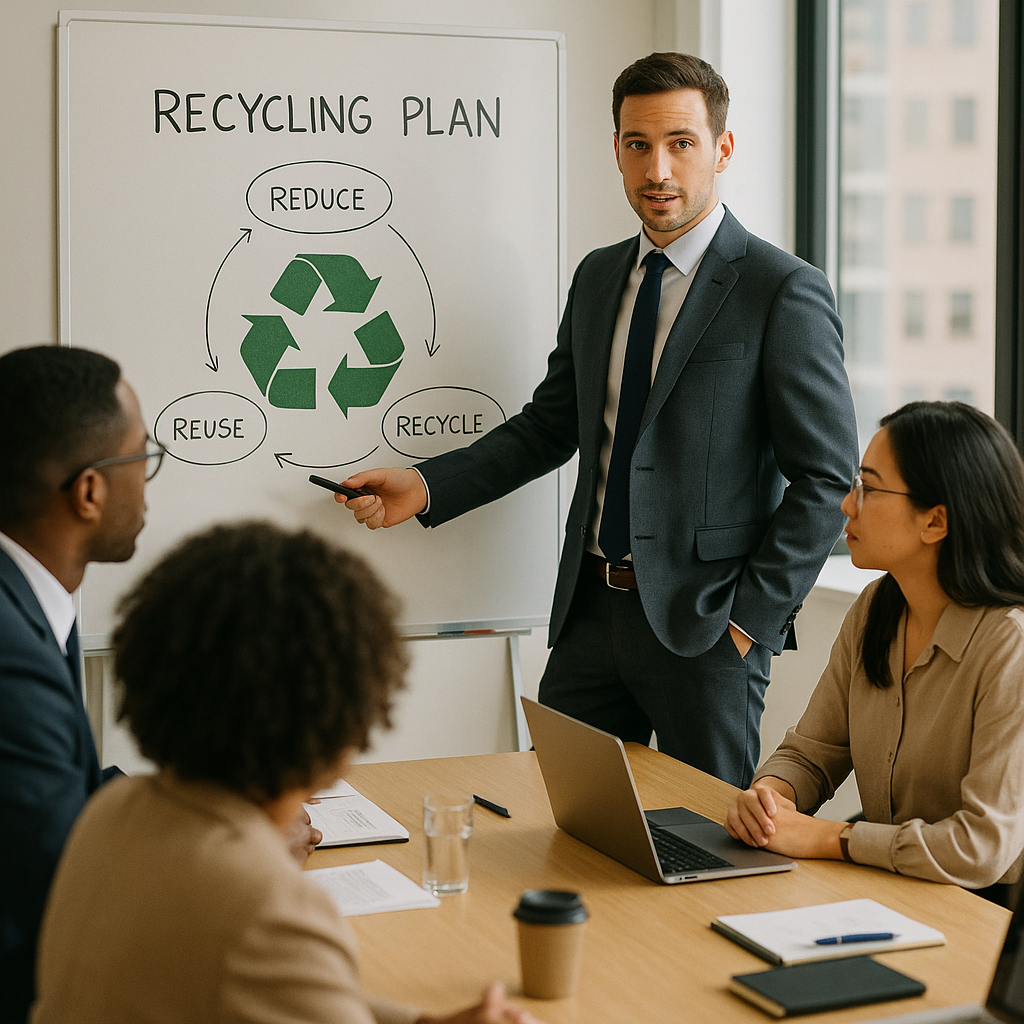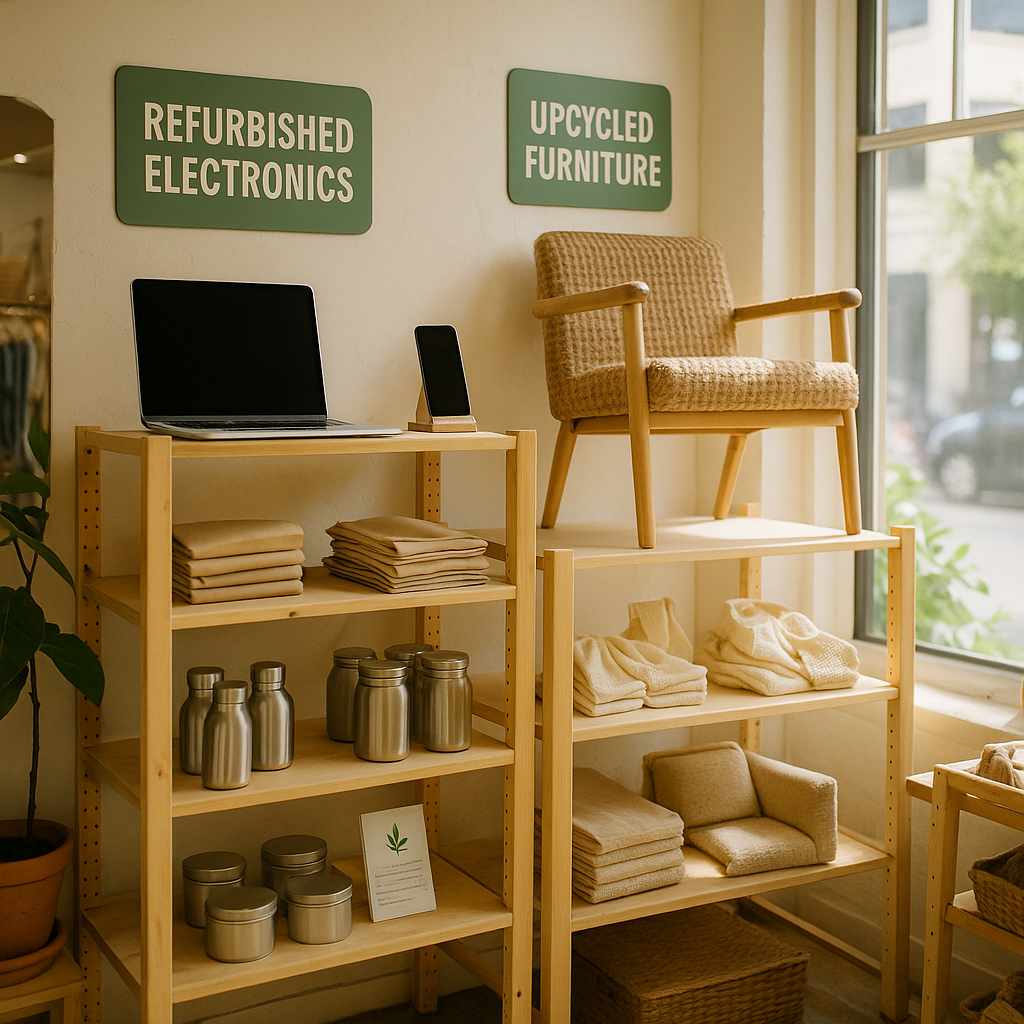5901 Botham Jean Blvd, Dallas, TX 75215
Circular Economy Business Models: How to Transition from Linear to Circular
September 11, 2025The traditional business approach of taking resources, making products, and discarding waste has reached its limits. Circular economy business models offer a more sustainable alternative. These models create systems that are regenerative by design, keeping materials and products in use for as long as possible.
At their core, circular economy business models work to maximize resource value throughout a product’s lifecycle. Instead of extracting new materials for each manufacturing cycle, these models prioritize reuse, repair, refurbishment, and recycling. The goal is simple yet effective: retain value that would otherwise be lost when products reach the end of their life.
Circular business models come in various forms. Some companies focus on recycling resources and using circular feedstocks. Others extend product lifespans through repair services and modular design. Many are shifting to service-based approaches where customers pay for product use rather than ownership. They are united by a commitment to move beyond the linear economic model that has dominated for decades.
What are the key strategies for implementing circular business models?

Transforming from a traditional linear business model to a circular one requires strategic approaches that fundamentally rethink how products are designed, sold, and managed throughout their lifecycle. Companies shifting toward circularity typically employ three main strategies, often combining them for maximum environmental and economic benefit.
1. Retain Product Ownership (RPO)
RPO involves businesses maintaining ownership of their products while providing the service or function to customers. This strategy encourages companies to build durable, efficient products since they remain responsible for maintenance and end-of-life management.
- Leasing models – Furniture company IKEA has implemented buyback and rental services that allow customers to use products without owning them. This gives IKEA control over product lifecycles and materials.
- Subscription services – Philips offers lighting-as-a-service to commercial clients, selling the benefit of light rather than light fixtures. The company maintains ownership of the hardware, handles maintenance, and can easily recover materials when upgrades are needed.
- Pay-per-use systems – Mobility companies like Swapfiets provide bicycles on a subscription basis, handling all repairs and maintenance while retaining ownership of the physical assets.
2. Product Life Extension (PLE)
PLE focuses on designing products that remain functional and valuable for as long as possible through durability, repairability, upgradability, and refurbishment.
- Design for durability – Outdoor clothing company Patagonia designs products with longevity in mind and offers lifetime warranties, encouraging customers to repair rather than replace.
- Repair services – Electronics manufacturers are increasingly building products with modular components that can be easily replaced or upgraded, extending the useful life of the overall product.
- Refurbishment programs – Apple’s refurbished product program takes used devices, professionally restores them, and resells them with warranties, keeping high-value products in circulation longer.
3. Design for Recycling (DFR)
DFR involves rethinking product design and manufacturing processes to facilitate material recovery and reuse at the end of a product’s life. This strategy ensures materials maintain their value and can be reincorporated into production cycles.
- Material selection – Companies like Interface carpet manufacturers design products using materials that can be easily separated and recycled, avoiding composite materials that are difficult to process.
- Streamlined disassembly – Automobile manufacturers are designing vehicles with easier disassembly in mind, using fewer fasteners and more uniform materials to simplify recycling.
- Closed-loop systems – Aluminum companies like Novelis have developed processes to repeatedly recycle aluminum without quality loss, significantly reducing energy consumption compared to virgin material production.
Most successful circular business models employ combinations of these strategies tailored to their specific industry and product type. For instance, a smartphone manufacturer might implement a leasing program (RPO), design phones for easy repair and component upgrades (PLE), and ensure materials can be recovered and recycled at end-of-life (DFR). This comprehensive approach maximizes resource efficiency while creating new revenue streams and stronger customer relationships.
By reimagining business models through these strategies, companies can reduce waste, conserve resources, and potentially increase profitability while contributing to a more sustainable circular economy.
| Retain Product Ownership (RPO) | Businesses maintain ownership of products, offering them as a service. Examples include leasing models, subscription services, and pay-per-use systems like IKEA’s buy-back program and Philips’ lighting-as-a-service model. |
| Product Life Extension (PLE) | Focuses on designing products for durability and repair. Examples include Patagonia’s durable clothing and Apple’s refurbishment programs. |
| Design for Recycling (DFR) | Involves rethinking product design for easier disassembly and material recovery. Examples include Interface’s recyclable materials and Novelis’ aluminum recycling processes. |
What are the business benefits of circular economy models?
Circular economy models offer compelling business advantages that extend beyond environmental benefits. Companies implementing these systems are discovering significant financial and operational gains that enhance their competitive edge in today’s resource-constrained marketplace.
Cost reduction is one of the most immediate benefits for businesses. By reusing materials and optimizing resources, companies can significantly lower their operating expenses. Internal material recycling and more efficient processes directly reduce costs associated with raw material purchases and waste management. Many organizations report positive returns on investment within relatively short timeframes after transitioning to circular models.
Revenue generation opportunities arise as businesses transform what was formerly considered waste into valuable resources. Manufacturing byproducts or residual materials from one production process can become inputs for another production line or even another industry entirely. This ability to create value from former waste streams allows companies to diversify their income sources and explore entirely new markets.
Enhanced Market Resilience and Competitive Positioning
Market resilience improves significantly for companies embracing circular approaches. A recent Bain and World Economic Forum survey revealed that nearly two-thirds of businesses believe circular strategies strengthen their operational resilience. By reducing dependence on volatile raw material markets, companies protect themselves against supply chain disruptions and sudden price fluctuations.
Competitive differentiation becomes possible as consumer preferences increasingly favor sustainable practices. Businesses implementing circular models not only comply with stricter environmental regulations but also improve their reputation and strengthen brand loyalty. This is particularly valuable as sustainability becomes a key decision factor for consumers, investors, and business partners.
Innovation flourishes in circular systems. The transition requires companies to reimagine their entire value chain, from product design to end-of-life recovery. This process often generates breakthrough ideas that can transform industries and open new market opportunities.
Financial Performance and Growth Opportunities
The financial impact of circular models is substantial. Studies suggest the circular economy represents a $4.5 trillion economic opportunity globally. More than 70% of manufacturing executives expect circular business solutions to increase their revenue by 2027, according to the Bain survey. Additionally, circular approaches may boost GDP by 1.1% through more efficient resource utilization and new business development.
Product lifespan extension creates additional revenue streams through repair, refurbishment, and secondary markets for used goods. This strategy is particularly effective in high-value durable goods industries. Companies like Siemens Mobility have extended their products’ operational life while reducing maintenance costs by up to 15% through predictive maintenance and advanced recycling techniques.
Capacity-sharing models transform traditional ownership paradigms by offering products as services. This approach generates stable, recurring revenue streams rather than one-time sales. Trane Technologies exemplifies this strategy with its HVAC rental services, experiencing over 10% annual growth in regions with high demand for energy-efficient cooling solutions.
Strategic Advantages for Forward-Thinking Organizations
Risk mitigation becomes more effective as circular models reduce exposure to resource scarcity and regulatory changes. As governments worldwide implement stricter environmental policies, companies with established circular practices gain a significant advantage over competitors scrambling to adapt.
Customer engagement deepens through circular business models. Product-as-a-service offerings create ongoing customer relationships rather than one-time transactions. These extended interactions provide valuable insights into customer preferences and usage patterns, enabling companies to continuously improve their offerings.
Talent attraction and retention improve as sustainability becomes increasingly important to employees. Companies with strong circular economy initiatives often report higher employee satisfaction and engagement, with staff feeling proud to contribute to meaningful environmental solutions.
Capital access expands as sustainable investment grows. Companies adopting circular practices attract significant capital from funds and investors prioritizing environmental, social, and governance criteria. This financial support accelerates the transition toward more sustainable and profitable business models.
What are some successful examples of circular economy business models?

Circular economy business models are redefining industries worldwide, demonstrating that sustainability and profitability can coexist. Several innovative companies have effectively adopted these models, achieving notable environmental and economic gains. Here are some exemplary cases illustrating the practical use of circular principles.
Renault: Pioneering Automotive Remanufacturing
Renault is a prominent leader in circular economy practices within the automotive industry. Their remanufacturing program at the Choisy-le-Roi plant in France serves as a model for resource efficiency. The company collects used parts from its dealer network, remanufactures them to original specifications, and sells them with the same warranty as new parts but at 50-70% of the cost.
This approach yields impressive results. Renault saves 10-15% on material costs for components while significantly reducing environmental impact. Their remanufacturing process uses 80% less energy, 88% less water, and produces 70% less waste compared to manufacturing new parts. The program has evolved into a substantial business, generating over €120 million in annual revenue.
Philips: Healthcare Equipment as a Service
Philips has transformed the healthcare equipment sector by moving from selling products to providing comprehensive solutions through service-based models. Instead of purchasing expensive medical equipment outright, healthcare providers can access advanced technology through long-term partnerships where Philips maintains ownership of the physical assets.
This innovative approach allows Philips to manage equipment upgrades, refurbish systems, reuse parts, and recycle materials efficiently. The company has achieved 50-90% material reuse through refurbishing, including recovering 940 tons of medical imaging equipment in a year. Currently, 9% of Philips’ total revenue is derived from circular activities, with a target to reach 15% by next year.
Michelin: Fleet Tire Management Solutions
Michelin has revamped its business model with the EFFITIRES™ program, where customers pay for kilometers traveled instead of purchasing tires upfront. This service-based approach currently supports over 320,000 vehicles globally, with Michelin aiming to double its service and solution revenue soon.
The program maximizes tire use by ensuring tires are used to the last possible millimeter of rubber before being regrooved and retreaded. This extends product life significantly while enhancing fleet efficiency and productivity. By fostering long-term partnerships with customers, Michelin strengthens customer loyalty and reduces resource consumption. The model allows Michelin to maintain its core manufacturing business while creating additional value through services.
TerraCycle: Finding Value in Difficult-to-Recycle Waste
TerraCycle has built its entire business model around recycling materials that conventional systems can’t process. The company collaborates with major brands to implement specialized recycling programs for items like cigarette butts, coffee capsules, and beauty product packaging.
Since 2012, TerraCycle’s Cigarette Waste Recycling Program has operated across 363 cities, diverting over 75 million tons of cigarette waste from landfills. The collected materials are transformed into industrial products like plastic pallets, while residual tobacco and ash are composted. Their innovative approach has resulted in partnerships with over 100 major brands and presence in 21 countries, turning waste challenges into business opportunities.
Novelis: Closing the Loop on Aluminum
Novelis, the global leader in rolled aluminum products, has fundamentally transformed its resource management approach. The company increased the average recycled content in its products from 30% to 53%, significantly reducing its environmental footprint and dependency on virgin materials.
A key element in this strategy was opening a €200 million aluminum recycling center in Germany—the largest and most advanced of its kind. With a capacity to recycle up to 400,000 metric tons of aluminum scrap annually, the center potentially saves 3.7 million metric tons in CO2 emissions. This vertical integration helps Novelis separate economic productivity from energy consumption while protecting against commodity price volatility.
| Company | Strategy | Key Circular Approach | Benefits |
| IKEA | Retain Product Ownership | Buyback and rental services for furniture | Control over product lifecycle and materials |
| Philips | Retain Product Ownership | Lighting-as-a-service | Material recovery and ongoing maintenance |
| Patagonia | Product Life Extension | Design for durability and lifetime warranties | Encourages repair over replacement |
| Apple | Product Life Extension | Refurbishment programs for electronics | Keeps high-value products in circulation longer |
| Novelis | Design for Recycling | Aluminum recycling with closed-loop systems | Reduces energy consumption and maintains quality |
Interface: Transforming the Carpet Industry
Interface has transformed the carpet manufacturing industry through its Net-Works initiative. This innovative program addresses ocean pollution by collecting discarded fishing nets from coastal communities and turning them into recycled nylon for carpet production.
More than 2 million kilograms of fishing nets have been collected, preventing them from polluting marine ecosystems. Besides the environmental impact, Net-Works has provided supplemental income to over 2,200 families in coastal areas. The recycled nylon is successfully used in Interface’s carpet tiles, with some product lines containing up to 100% recycled content.
Apple: Electronics Recycling and Refurbishment
Apple has made substantial progress in creating a closed-loop supply chain for electronics. Through their Apple Trade In program, consumers can trade used devices for credit or recycling. Reconditioned devices are sold as Apple Certified Refurbished products with full warranties, extending product lifespans.
For non-refurbishable devices, Apple uses specialized robots like Daisy to disassemble products and recover valuable materials. This approach has enabled Apple to incorporate 100% recycled rare earth elements in iPhone magnets and 100% recycled aluminum in various products. In a single year, Apple recovered 61 million pounds of materials through these programs, showcasing how high-tech methods can advance circular principles.
These diverse examples reveal that circular economy models can thrive across industries, from manufacturing and healthcare to fashion and technology. By redesigning processes, embracing service-based approaches, and extracting value from waste, companies are finding that circularity offers both environmental and compelling business benefits.
How can companies transition to circular economy business models?

Transitioning to a circular economy requires companies to fundamentally rethink resource use and business operations. This shift moves organizations from the traditional ‘take-make-dispose’ linear model towards systems that maximize resource value and minimize waste. For companies making this transition, a structured approach is essential.
Resource mapping is a critical first step in identifying circular opportunities. Companies should conduct comprehensive analyses of their material flows, examining where resources enter operations, how they’re used, and where waste occurs. This often reveals unexpected opportunities for circularity and helps pinpoint areas of waste that can be transformed into value.
Selecting the Right Circular Strategy
Companies must choose circular strategies aligning with their unique capabilities, resources, and operational constraints. Three main approaches exist, often combined for successful transitions:
- Retain product ownership – Companies maintain ownership of products through rental or leasing models rather than selling them outright. This works best for complex products with significant embedded value or infrequently needed items.
- Product life extension – Businesses focus on designing products to last longer with durability, repair services, or remanufacturing. This can become a competitive differentiator and justify premium pricing.
- Design for recycling – Companies redesign products and manufacturing processes to maximize material recovery, often requiring partnerships with organizations possessing specialized recycling expertise.
The optimal strategy depends on how easily a company can reclaim products from customers and recover value. For instance, heavy or bulky items may be difficult to transport for recycling, while products with active secondary markets might be challenging to reclaim from customers.
Implementing Through Pilot Projects
Beginning with focused pilot projects allows companies to test circular approaches before full-scale implementation. These limited initiatives provide valuable learning opportunities and help identify challenges. Successful companies typically start with small-scale experiments, carefully measure results, and adjust their approach based on findings.
For example, H&M Group’s Circular Innovation Lab tests new sustainable materials with partner startups before integrating successful innovations into their broader supply chain. This allows the company to refine processes and build necessary capabilities before scaling up.
Building Collaborative Networks
Circularity rarely succeeds in isolation. Companies should develop partnerships across their value chain and with external organizations to create effective circular systems. These collaborations might include:
- Suppliers who can provide recycled or sustainable materials
- Specialized recycling partners with technical expertise
- Logistics providers who can manage reverse supply chains
- Industry peers for shared infrastructure or knowledge
Nike exemplifies this collaborative approach through initiatives like Nike Grind, partnering with companies that transform recycled athletic shoes into materials for new products like playing fields and carpet padding.
Investing in Enabling Technologies
Circular business models often require supporting technologies to function effectively. Companies should invest in:
- Product design tools facilitating disassembly and recycling
- Tracking systems monitoring products throughout their lifecycle
- Advanced recycling technologies improving material recovery
- Digital platforms connecting customers to take-back or repair services
Apple demonstrates this investment approach with technologies like Daisy, a robot capable of disassembling up to 200 iPhones per hour to recover valuable materials for reuse in new devices.
Cultivating a Circular Mindset
Perhaps most challenging is the cultural shift required throughout the organization. Companies must engage employees at all levels to build understanding and commitment to circular principles, involving:
- Education programs about circular economy concepts
- Cross-functional teams identifying circular opportunities
- Incentive structures rewarding circular innovation
- Clear communication about the business case for circularity
Successful circular transitions require sustained leadership commitment and a willingness to adapt as the company evolves. Without this mindset, even well-designed circular initiatives will struggle to gain traction.
Overcoming Common Transition Challenges
Companies implementing circular models typically face several hurdles. Understanding these challenges in advance allows businesses to develop appropriate mitigation strategies:
- Supply chain restructuring – Circular models often require developing reverse logistics systems and new supplier relationships
- Customer education – Companies must help customers understand the benefits of circular products and services
- Financial barriers – Initial investments in redesign, infrastructure, and new technologies can be substantial
Organizations can address these challenges through phased implementation approaches, collaborative partnerships sharing costs and risks, and customer engagement strategies clearly communicating the value proposition of circular offerings.
Interface, the commercial flooring company, demonstrates how adaptability supports successful circular transitions. After an unsuccessful attempt to implement a leasing model, the company pivoted to focus on sustainable materials and manufacturing processes, ultimately reducing its carbon footprint by 69% while leveraging its core manufacturing strengths.
By following these steps and remaining flexible in their approach, companies can successfully transition to circular economy business models that deliver both environmental benefits and business value.
Conclusion: The Future of Circular Economy Business Models

Circular economy business models offer an innovative path for companies aiming for sustainable growth in our resource-limited environment. These models provide not only environmental benefits but also significant economic advantages. A recent survey showed that over 70% of manufacturing executives expect circular solutions to boost revenue by 2027, while nearly two-thirds anticipate enhanced operational resilience.
The case for circularity strengthens as resource scarcity grows and regulatory pressures increase. Companies adopting circular strategies position themselves as leaders in innovation. By designing products for longevity, implementing take-back programs, offering products-as-services, or incorporating recycled materials, businesses can reduce costs, unlock new revenue streams, and foster stronger customer relationships.
For organizations looking to enhance their waste management and recycling strategies as part of a circular approach, contact Okon Recycling at 214-717-4083.
